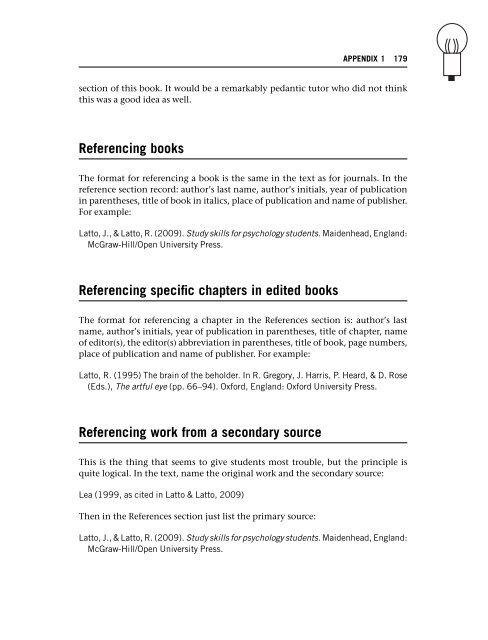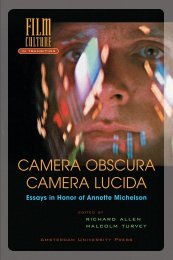Psychology - Forgot your username
Psychology - Forgot your username
Psychology - Forgot your username
You also want an ePaper? Increase the reach of your titles
YUMPU automatically turns print PDFs into web optimized ePapers that Google loves.
section of this book. It would be a remarkably pedantic tutor who did not think<br />
this was a good idea as well.<br />
Referencing books<br />
The format for referencing a book is the same in the text as for journals. In the<br />
reference section record: author’s last name, author’s initials, year of publication<br />
in parentheses, title of book in italics, place of publication and name of publisher.<br />
For example:<br />
Latto, J., & Latto, R. (2009). Study skills for psychology students. Maidenhead, England:<br />
McGraw-Hill/Open University Press.<br />
Referencing specific chapters in edited books<br />
The format for referencing a chapter in the References section is: author’s last<br />
name, author’s initials, year of publication in parentheses, title of chapter, name<br />
of editor(s), the editor(s) abbreviation in parentheses, title of book, page numbers,<br />
place of publication and name of publisher. For example:<br />
Latto, R. (1995) The brain of the beholder. In R. Gregory, J. Harris, P. Heard, & D. Rose<br />
(Eds.), The artful eye (pp. 66–94). Oxford, England: Oxford University Press.<br />
Referencing work from a secondary source<br />
This is the thing that seems to give students most trouble, but the principle is<br />
quite logical. In the text, name the original work and the secondary source:<br />
Lea (1999, as cited in Latto & Latto, 2009)<br />
Then in the References section just list the primary source:<br />
APPENDIX 1 179<br />
Latto, J., & Latto, R. (2009). Study skills for psychology students. Maidenhead, England:<br />
McGraw-Hill/Open University Press.






